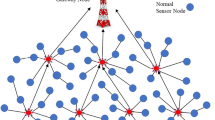Abstract
Wireless sensor networks (WSNs) are typically deployed environments, often very hostile and without assistance. A certain level of security must be provided. However, the resource constraint is the most important characteristic of this network. Indeed, WSNs are limited in terms of calculation, CPU, battery, etc. Therefore, a solution that aims to conserve these resources is widely desired. In this paper, we focus on the problem of encryption algorithm complexity. Some of the existing encryption algorithms provide high calculation cost, require large memory and are not applicable for WSNs scenarios. Based on Feistel structure, we propose a novel ultra-lightweight encryption algorithm, named ULEA. Besides diffusion and confusion of data, ULEA assumes minor encryption rounds with simplified transformations and functions to complex the cipher. The security analysis and experimental results suggest that the ULEA algorithm is an appropriate, low storage space, energy-efficient encryption process with high security for WSNs.













Similar content being viewed by others
References
Biham E, Shamir A (1990) Differential cryptanalysis of des-like cryptosystems. J Cryptol 4:3–72. https://doi.org/10.1007/BF00630563
Budhwar P (2015) Tinyos: an operating system for wireless sensor networks. J Comput Sci Technol 6(1):141–145
Chen T, Blasco J, Kupwade PH (2019) Cryptography in WSNs, pp 783–820. https://doi.org/10.1007/978-3-319-91146-5_21
Coppersmith D (1994) The data encryption standard (DES) and its strength against attacks. IBM J Res Dev 38(3):243–250. https://doi.org/10.1147/rd.383.0243
Dhakne AR, Chatur PN (2017) Detailed survey on attacks in wireless sensor network. In: International Conference on Data Engineering and Communication Technology, pp 319–331. https://doi.org/10.1007/978-981-10-1678-3_31
Diffie W, Hellman M (1976) New directions in cryptography. IEEE Trans Inf Theory 22(6):644–654. https://doi.org/10.1109/TIT.1976.1055638
Forouzan BA (2008) Cryptography and network security. Mc Graw Hill, New York
Hong D, Sung J et al (2006) Hight: a new block cipher suitable for low-resource device. In: Cryptographic Hardware and Embedded Systems—CHES, pp 46–59. https://doi.org/10.1007/11894063_4
Karagiannis A, Vouyioukas D (2013) Performance enhancement of TinyECC based on multiplication optimizations. Secur Commun Netw 6(2):151–160. https://doi.org/10.1002/sec.422
Karagiannis A, Vouyioukas D (2015) A framework for the estimation and validation of energy consumption in wireless sensor networks. J Sens. https://doi.org/10.1155/2015/124987
Kotel S, Zeghid M, Machhout M, Tourki R (2017) Lightweight encryption algorithm based on modified XTEA for low-resource embedded devices. In: 21st International Database Engineering and Applications Symposium, pp 192–199. https://doi.org/10.1145/3105831.3105853
Kukkurainen J, Soini M, Sydanheimo L (2010) Rc5-based security in wireless sensor networks: utilization and performance. WSEAS Trans Comput 9(10):1191–1200
Lauter K (2004) The advantages of elliptic curve cryptography for wireless security. IEEE Wirel Commun 11(1):62–67. https://doi.org/10.1109/MWC.2004.1269719
Li J, Serpen G (2012) Simulating heterogeneous and larger-scale wireless sensor networks with TOSSIM TinyOS emulator. Proc Comput Sci 12(3):374–379. https://doi.org/10.1016/j.procs.2012.09.089
Matsui E (1993) Linear cryptoanalysis method for des cipher. In: Advances in Cryptology-EUROCRYPT, pp 386–397. https://doi.org/10.1007/3-540-48285-7_33
Milad A, Muda H, Muhamad N, Algaet M (2012) Comparative study of performance in cryptography algorithms (Blowfish and Skipjack). J Comput Sci 8(01):1191–1197. https://doi.org/10.3844/jcssp.2012.1191.1197
National Institute of standards and Technology (2002) FIPS PUB 180-2: Secure Hash Standard
Novelan M, Husein A, Harahap M, Aisyah S (2018) Sms security system on mobile devices using tiny encryption algorithm. J Phys Conf Ser 1007(4):12–37. https://doi.org/10.1088/1742-6596/1007/1/012037
Panda M (2015) Data security in wireless sensor networks via AES algorithm. In: IEEE 9th International Conference on Intelligent Systems and Control (ISCO), pp 1–5. https://doi.org/10.1109/ISCO.2015.7282377
Patel R, Kumar S (2018) Wireless sensor networks’ challenges and future prospects. In: International Conference on System Modeling, Advancement in Research Trends (SMART), pp 60–65. https://doi.org/10.1109/SYSMART.2018.8746937
Patel ST, Mistry NH (2015) A survey: lightweight cryptography in WSN. In: International Conference on Communication Networks (ICCN), pp 11–15. https://doi.org/10.1109/ICCN.2015.3
Rebeiro C, Nguyen PH, Mukhopadhyay D, Poschmann A (2013) Formalizing the effect of Feistel cipher structures on differential cache attacks. IEEE Trans Inf Forensics Secur 8(8):1274–1279. https://doi.org/10.1109/TIFS.2013.2267733
Shannon C (1949) Communication theory of secrecy systems. Bell Syst Tech J 8(9):656–715. https://doi.org/10.1002/j.1538-7305.1949.tb00928.x
SunilKumar K, Shivashankar (2017) A review on security and privacy issues in wireless sensor networks. In: IEEE International Conference on Recent Trends in Electronics, Information and Communication Technology (RTEICT), pp 1979–1984. https://doi.org/10.1109/RTEICT.2017.8256945
Tripathy S, Sukumar N (2009) LCASE: Lightweight cellular automata-based symmetric-key encryption. Int J Netw Secur 8(2):243–252
Author information
Authors and Affiliations
Corresponding author
Additional information
Publisher's Note
Springer Nature remains neutral with regard to jurisdictional claims in published maps and institutional affiliations.
Rights and permissions
About this article
Cite this article
Hayouni, H., Hamdi, M. A novel energy-efficient encryption algorithm for secure data in WSNs. J Supercomput 77, 4754–4777 (2021). https://doi.org/10.1007/s11227-020-03465-x
Accepted:
Published:
Issue Date:
DOI: https://doi.org/10.1007/s11227-020-03465-x




